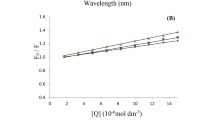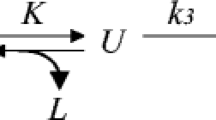Abstract
Purpose. The chemical and thermal stability of five species of mammalian serum albumins (human, bovine, dog, rabbit, and rat) were investigated, and conformational stabilities were compared to obtain structural information about the different albumins.
Methods. The chemical stability was estimated by using guanidine hydrochloride (GdnCl), and monitored by fluorometry and circular dichroism (CD). Thermal stability was evaluated by differential scanning calorimetry (DSC).
Results. In human, bovine, and rat albumin, two transitions were observed when GdnCl-induced denaturation was monitored fluorometrically, indicating at least one stable intermediate, although, in dog and rabbit albumin, only one transition was observed. However, GdnCl denaturation, as monitored by the ellipticity, showed a two-state transition in all species used in this study. Since these proteins, showing two transitions, contained a conserved tryptophan residue within domain II, these structural changes might have occurred in domain II during intermediate formation. DSC measurements showed that human, bovine, and rat albumin exhibited single sharp endotherms and these were clearly consistent with a two-state transition, while the deconvolution analysis of broad thermograms observed for dog and rabbit albumin showed that the absorption peaks could be approximated by a two-component composition, and were consistent with independent transitions of two different cooperative blocks.
Conclusions. These experimental results demonstrate that species differences exist with respect to the conformational stability and the mechanism of the unfolding pathway for mammalian albumin.
Similar content being viewed by others
REFERENCES
Part I: T. Kosa, T. Maruyama, and M. Otagiri. Species differences of serum albumins: I. Drug binding sites. Pharm. Res. 14:1608–1613 (1997).
T. J. Peter. All about albumin. Biochemistry, Genetics, and Medical Applications, Academic Press, California, pp. 133–153, 1996.
X. M. Hc and D. C. Carter. Atomic structure and chemistry of human serum albumin. Nature 358:209–215 (1992).
J. X. Ho, E. W. Holowachuk, E. J. Norton, P. D. Twigg, and D. C. Carter. X-ray and primary structure of horse serum albumin (Equus caballus) at 0.27-nmresolution. Eur. J. Biochem. 215:205–212 (1993).
G Picó. Thermodynamic aspects of the thermal stability of human serum albumin. Biochem. Mol. Biol. Int. 36:1017–1023 (1995).
K. Takeda, I. Yoshida, and K. Yamamoto. Changes of fluorescence lifetime and rotational correlation time of bovine serum albumin labeled with 1-dimethylaminonaphthalene-5-sulfonyl chloride in guanidine and thermal denaturations. J. Protein Chem. 10:17–23 (1991).
K. Wallevik. Reversible denaturation of human serum albumin by pH, temperature, and guanidine hydrochloride followed by optical rotation. J. Biol. Chem. 248:2650–2655 (1973).
M. Y. Khan, S. K. Agarwal, and S. Hangloo. Urea-induced structural transformations in bovine serum albumin. J. Biochem. 102:313–317 (1987).
S. Katz and J. Denis. Mechanism of denaturation of bovine serum albumin by urea and urea-type agents. Biochim. Biophys. Acta 188:247–254 (1969).
P. D. Ross, J. S, Finlayson, and A. Shrake. Thermal stability of human albumin measured by differential scanning calorimetry. Vox Sang. 47:19–27 (1984).
P. D. Ross and A. Shrake. Decrease in stability of human albumin with increase in protein concentration. J. Biol. Chem. 263:11196–11202 (1988).
L. Feng and J. D. Andrade. Protein adsorption on low-temperature isotropic carbon: I. Protein conformational change probed by differential scanning calorimetry. J. Biomed. Mater. Res. 28, 735–743 (1994).
A. Shrake and P. D. Ross. Biphasic denaturation of human albumin due to ligand redistribution during unfolding. J. Biol. Chem. 263:15392–15399 (1988).
S. Gumpen, P. O. Hegg, and H. Martens, Thermal stability of fatty acid-serum albumin complexes studied by differential scanning calorimetry. Biochim. Biophys. Act 574:189–196 (1979).
K. P. Murphy and E. Freire. Thermodynamics of structural stability and cooperative folding behavior to proteins. Adv. Protein Chem. 43:313–361 (1992).
P. L. Privalov. Stability of proteins: small globular proteins. Adv. Protein Chem. 33:167–241 (1979).
M. Yamasaki, H. Yano, and K. Aoki. Differential scanning calorimetric studies on bovine serum albumin: I. Effects of pH and ionic strength, Int. J. Biol, Macromol, 12:263–268 (1990).
D. Shortle, Staphylococcal nuclease: a showcase of m-value effects. Adv. Protein Chem. 46:217–247 (1995).
Author information
Authors and Affiliations
Rights and permissions
About this article
Cite this article
Kosa, T., Maruyama, T. & Otagiri, M. Species Differences of Serum Albumins: II. Chemical and Thermal Stability. Pharm Res 15, 449–454 (1998). https://doi.org/10.1023/A:1011932516717
Issue Date:
DOI: https://doi.org/10.1023/A:1011932516717




